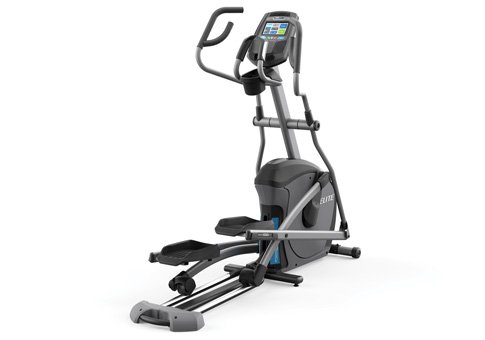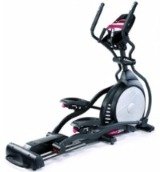Elliptical Trainer Glossary - What it All Means
The elliptical trainer glossary will help you understand the terms found on this site.
Elliptical Trainer – A stationary exercise machine designed to simulate walking or running by following the natural elliptical pattern the feet follow with each stride. An elliptical trainer is designed so that the feet never leave the foot pedals, reducing the stress on joints, especially those of the knees, ankles and hips. Many provide an upper body workout as well with moving handlebars that may be moved back and forth with the movement of the feet, but not all elliptical trainers have them. Elliptical home trainers are designed to provide an effective cardiovascular workout by raising the heart rate and tone muscle groups through the action of the legs.
Elliptical Motion – The oval shaped pattern the human foot follows in a natural stride. It is this elliptical pattern or motion that makes an elliptical trainer unique and makes it both effective and comfortable.
Cross Training – Combining different types of exercise or workouts in order to effectively target different muscle groups. Elliptical machines are sometimes called cross trainers because the forward and backward motions and different settings of tension and incline work out different muscle groups, as does the upper body workout.
Hybrid Machine – These are relatively new workout machines like the Max Trainer that combines an elliptical with one or more other machines in one, like a stepper, a treadmill, a bike or a skier. These machines allow you to target many different muscle groups.
Weight Bearing Exercise – Any exercise in which the body not only exerts itself to move, but supports the body’s weight. On an elliptical trainer, you are supporting your own body weight while moving, which provides a more effective exercise routine than biking, where you are not bearing your weight.
Low/No Impact Training – Exercise that does not involve impact or jarring of the joints because you are not picking up your feet and putting them back down, which drastically increases pressure on your joints. People who have arthritis or back problems should use low/no impact training such as elliptical trainers.
Perceived Exertion – A measurement of how much energy it feels like you are using during exercise. Generally, you do not feel fatigued as easily using an elliptical trainer as you do with other forms of exercise. Because of this lower rate of perceived exertion, you tend to burn more calories in the same amount of time because you are able to push yourself to work more efficiently.
Stride Length/Adjustable Stride – The stride length on an elliptical machine is the longest total width of the elliptical motion that can be achieved. On a machine with an adjustable stride, the stride length can be adjusted to accommodate individuals of extremely diverse heights, as taller people tend to have longer strides due to their leg length.
Upper/Lower Body Workout – The portions of the body that are being actively used during a particular exercise. An upper body workout focuses on the muscles of the arms, shoulders and back while a lower body workout focuses on the muscles of the legs, lower abdomen and buttocks.
Weight Capacity – Sometimes referred to as the “maximum user weight,” this simply refers to the heaviest weight that a user can be as suggested by the manufacturer.
Resistance – The amount of force or tension against which you are walking or running on an elliptical machine. You can increase the resistance of your workout to increase the amount of exertion. There are several types of resistance available on elliptical machines:
- Magnetic resistance (also referred to as Eddy Current Braking System), which is based on how close calibrated magnets are to the flywheel. The closer the magnets are, the higher the resistance, although the magnets don’t actually touch the flywheel at any point. These have almost no wear because they have no parts that rub together or touch.
- Manual resistance also uses a magnet (actually, they all do), but it is a U-shaped magnet that is manually adjusted when you move a lever or turn a dial so that it is brought closer to or farther away from the flywheel.
- Motorized resistance is achieved with a small motor that controls the position of the magnet relative to the flywheel. These tend to have many small parts and need more repairs than either manual or magnetic resistance brakes.
Programs – Workouts designed and pre-programmed into the elliptical machine that change settings, especially resistance, at various intervals in order to give you a particular type of workout. Some examples might be one to simulate a hike and another to simulate rough terrain. There are also heart rate programs designed to maximize your cardiovascular workout by achieving a particular heart rate goal. On some elliptical trainers, you can also develop your own programs.
Footprint – This refers to the size of the elliptical trainer in terms of how much floor space it takes up. The smaller the footprint, the less floor space it will need.
Foot Pedals – The pedals where you place your feet on the elliptical track of a crosstrainer. These are generally fairly long and broad to accommodate any size foot, and will be ridged or grooved to prevent slipping.
- Adjustable foot pedals allow you to adjust the height of the pedals so that the elliptical motion is a comfortable fit based on the height of the user.
- Articulating foot pedals follow the natural movement of the foot (which tends to tilt either backward or forward slightly) throughout the elliptical movement. This keeps the entire foot, including the heel, in contact with the pedal at all times.
- Pivoting foot pedals mimic the natural pivoting action of the ankle during elliptical movement. This keeps the ankle joint in proper alignment with the knees and hips at all times. The pivot of the foot pedals may be in any direction, and is usually only slight to be effective.
Heart Rate Monitors – These measure the user’s heart rate (how many beats per minute) while using the elliptical machine. The most accurate are wireless heart rate monitors that use a wireless chest strap that transmits the readings electronically from the strap to the console. Less expensive and more common on less expensive ellipticals are pulse grip monitors. These count the number of pulse beats in the hand while it is gripping a monitor, usually built into the handlebars of the elliptical trainer.
LCD – Liquid Crystal Display. Consoles that use LCD displays operate with less energy and are clearer to read than LED displays, but are more expensive to manufacture. They manipulate ambient light, so they need to be back-lit if you are going to see them well in low light or the dark. The LCD screen will have a high resolution and can be multi-colored. LCD is the display used on most computer monitors.
LED – Light Emitting Diode. Consoles that use LED displays tend to use more energy but are less expensive to manufacture. They are actually miniscule light bulbs that are lit by the movement of electrons when they are excited. LED lights do not have to be backlit and can be seen well in the dark as well as in bright light conditions. LED is the display used on many digital clocks.
iFit – A popular technology that can be downloaded from the Internet or purchased on computer microchips that contain customized workout plans compatible with your elliptical trainer. Benefits include customized programs, music and (for ellipticals with LCD viewing screens) scenic routes that you can download to your machine to vary and personalize your workout.
UPDATE: New Year's Elliptical Sales are going strong!
SEE THE BEST CURRENT DEALS HERE

Best By Price Range
Under $500
$500 - $1000
$1000 - $2000
$2000 - $3000
$3000 - $4000+
Elliptical Buying Guide

8 Features to Compare
Brake Systems
Stride Length
Front vs. Rear Drive
Warranties
Consumer Reviews

Here is your chance to rant or rave about the elliptical you use at home or at the fitness center.
